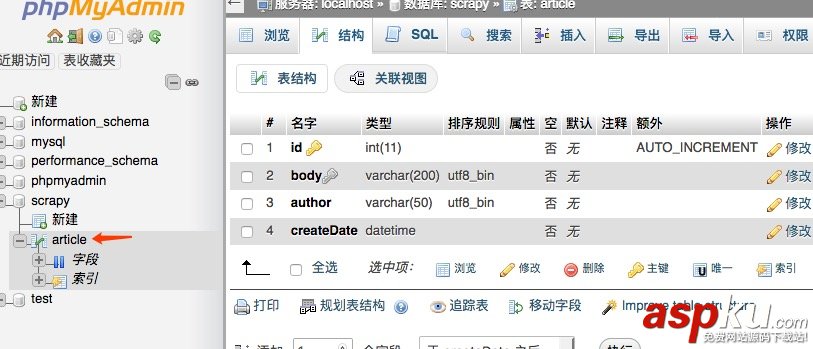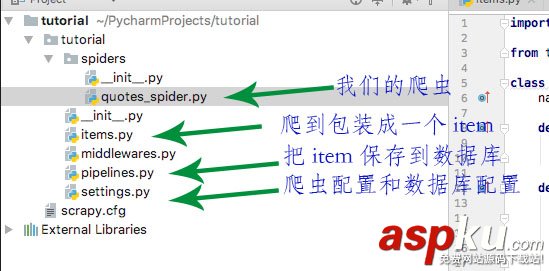前言
本文主要给大家介绍了关于scrapy爬到的数据保存到mysql(防止重复)的相关内容,分享出来供大家参考学习,下面话不多说了,来一起看看详细的介绍吧。
1.环境建立
1.使用xmapp安装php, mysql ,phpmyadmin
2.安装python3,pip
3.安装pymysql
3.(windows 略)我这边是mac,安装brew,用brew 安装scrapy
2.整个流程
1. 创建数据库和数据库表,准备保存
2.写入爬虫目标URL,进行网络请求
3.对爬返回数据进行处理,得到具体数据
4.对于具体数据保存到数据库中
2.1.创建数据库
首先创建一个数据库叫scrapy,然后创建一个表article,我们这里给body加了唯一索引,防止重复插入数据
---- Database: `scrapy`-- -- -------------------------------------------------------- ---- 表的结构 `article`-- CREATE TABLE `article` ( `id` int(11) NOT NULL, `body` varchar(200) CHARACTER SET utf8 COLLATE utf8_bin NOT NULL, `author` varchar(50) CHARACTER SET utf8 COLLATE utf8_bin NOT NULL, `createDate` datetime NOT NULL) ENGINE=InnoDB DEFAULT CHARSET=latin1; ---- Indexes for table `article`--ALTER TABLE `article` ADD PRIMARY KEY (`id`), ADD UNIQUE KEY `uk_body` (`body`);

弄好以后是这样的。
2.2 先看下整个爬虫项目的结构

quotes_spider.py是核心,负责对网络请求和对内容进行处理,然后对整理好的内容抛给pipelines进行具体处理,保存到数据库中,这样不会影响速度。
其他的看 图说明
2.2 写入爬虫目标URL,进行网络请求
import scrapyfrom tutorial.items import TutorialItemclass QuotesSpider(scrapy.Spider): name = "quotes" def start_requests(self): url = 'http://quotes.toscrape.com/tag/humor/' yield scrapy.Request(url) def parse(self, response): item = TutorialItem() for quote in response.css('div.quote'): item['body'] = quote.css('span.text::text').extract_first() item['author'] = quote.css('small.author::text').extract_first() yield item next_page = response.css('li.next a::attr("href")').extract_first() if next_page is not None: yield response.follow(next_page, self.parse)start_requests 就是要写入具体要爬的URL
parse就是核心的对返回的数据进行处理的地方,然后以item的形式抛出,接下来定义好下一个要爬的内容
2.3 items
# -*- coding: utf-8 -*-# Define here the models for your scraped items## See documentation in:# https://doc.scrapy.org/en/latest/topics/items.htmlimport scrapyclass TutorialItem(scrapy.Item): body = scrapy.Field() author = scrapy.Field() pass
2.4 pipelines
# -*- coding: utf-8 -*-# Define your item pipelines here## Don't forget to add your pipeline to the ITEM_PIPELINES setting# See: https://doc.scrapy.org/en/latest/topics/item-pipeline.htmlimport pymysqlimport datetimefrom tutorial import settingsimport loggingclass TutorialPipeline(object): def __init__(self): self.connect = pymysql.connect( host = settings.MYSQL_HOST, db = settings.MYSQL_DBNAME, user = settings.MYSQL_USER, passwd = settings.MYSQL_PASSWD, charset = 'utf8', use_unicode = True ) self.cursor = self.connect.cursor(); def process_item(self, item, spider): try: self.cursor.execute( "insert into article (body, author, createDate) value(%s, %s, %s) on duplicate key update author=(author)", (item['body'], item['author'], datetime.datetime.now() )) self.connect.commit() except Exception as error: logging.log(error) return item def close_spider(self, spider): self.connect.close();
2.5 配置
ITEM_PIPELINES = { 'tutorial.pipelines.TutorialPipeline':300}MYSQL_HOST = 'localhost'MYSQL_DBNAME = 'scrapy'MYSQL_USER = 'root'MYSQL_PASSWD = '123456'MYSQL_PORT = 33063.启动爬虫
scrapy crawl quotes
总结
以上就是这篇文章的全部内容了,希望本文的内容对大家的学习或者工作具有一定的参考学习价值,如果有疑问大家可以留言交流,谢谢大家对VEVB武林网的支持。
新闻热点
疑难解答